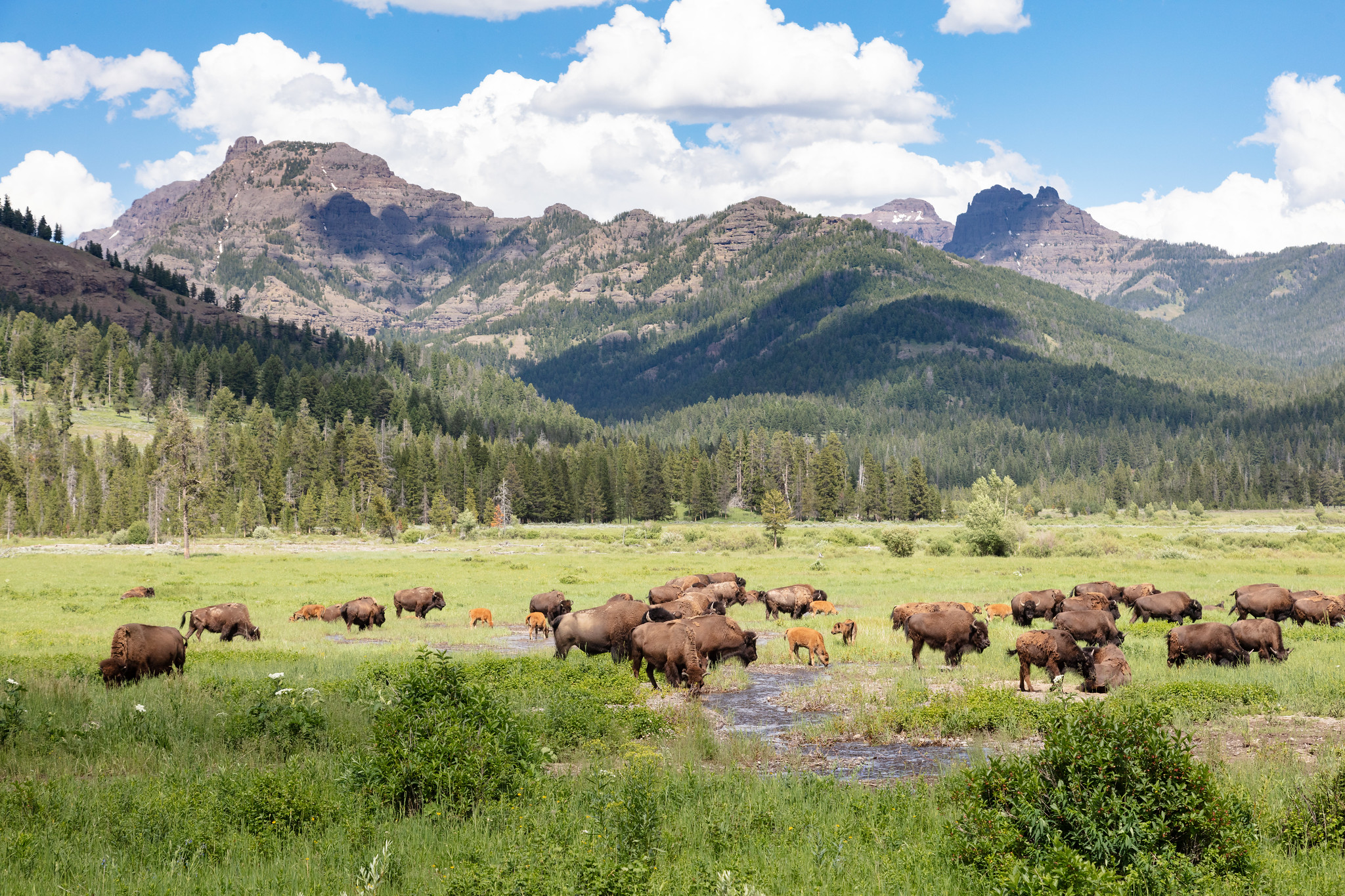
Yellowstone National Park: A Natural Wonderland of Wonders
Yellowstone National Park is one of the most iconic and diverse natural landscapes in the world. Located primarily in the U.S. state of Wyoming, though it also extends into Montana and Idaho, Yellowstone covers over 2.2 million acres, making it the first national park in the world. It was established on March 1, 1872, and has since become a UNESCO World Heritage Site, attracting millions of visitors every year to experience its geothermal wonders, abundant wildlife, and breathtaking landscapes. Whether you’re an adventure seeker, nature lover, or simply looking to relax and reconnect with the outdoors, Yellowstone offers something for everyone.
1. Geothermal Features: A Geological Wonderland
One of the most unique aspects of Yellowstone is its geothermal activity. The park sits atop a volcanic hotspot, making it home to more than 10,000 geothermal features, including hot springs, fumaroles (steam vents), mud pots, and geysers. The most famous of these is Old Faithful, a geyser that erupts with astonishing regularity, shooting water up to 185 feet into the air. Watching Old Faithful erupt is a truly mesmerizing experience, but the park offers many other geysers and hot springs that are equally spectacular.
Another must-see geothermal feature is the Grand Prismatic Spring, the largest hot spring in the United States and the third-largest in the world. The vibrant colors of the spring, ranging from deep blues to fiery oranges and reds, are caused by thermophilic bacteria that thrive in the hot waters. Visitors can view the spring from a boardwalk or a nearby overlook for a panoramic view of this stunning natural feature.
Yellowstone’s geothermal areas also contribute to its unique ecosystem. The warm waters in the park create a habitat for various forms of life, including microbial mats that add to the park’s scientific importance. Exploring the park’s geothermal zones provides an opportunity to witness the fascinating interplay between heat, water, and life in one of the world’s most dynamic environments.
2. Wildlife Watching: A Sanctuary for Animals
Yellowstone is renowned for its wildlife, offering some of the best opportunities for animal viewing in North America. The park is home to a diverse array of species, from the iconic American bison to wolves, grizzly bears, elk, and countless bird species. The vast and varied habitats in the park, including forests, meadows, and rivers, provide ample space for wildlife to thrive.
One of the highlights of visiting Yellowstone is the chance to see the bison, the largest land mammal in North America. Yellowstone’s bison population is one of the oldest and most genetically pure in the world, making them an essential part of the park’s ecosystem. Visitors can often see bison grazing in the Lamar Valley, a prime location for wildlife watching.
Another species that visitors often seek out is the gray wolf. Reintroduced to the park in the mid-1990s, wolves have flourished in Yellowstone, and the Lamar Valley is also a hotspot for wolf sightings. The presence of wolves has helped restore balance to the ecosystem by regulating populations of other animals like elk and deer, which in turn has affected the park’s vegetation and overall biodiversity.
Grizzly bears, black bears, and a variety of smaller mammals, including foxes, otters, and beavers, also roam the park. Bird watchers will be thrilled to find a wide variety of species, including eagles, osprey, and trumpeter swans, particularly around Yellowstone Lake and the Lamar Valley.
3. Yellowstone’s Scenic Beauty: Landscapes Beyond Compare
Beyond its geothermal features and wildlife, Yellowstone National Park is also famous for its dramatic and diverse landscapes. From towering mountains to lush forests and pristine lakes, the park is a haven for outdoor enthusiasts and photographers alike.
One of the most striking landscapes in Yellowstone is the Yellowstone Grand Canyon. This massive canyon, carved by the Yellowstone River, is over 1,000 feet deep and boasts stunning rock formations in shades of yellow, orange, and red. The Lower Falls of the Yellowstone River, with a drop of 308 feet, is one of the most photographed spots in the park. The canyon offers several vantage points, including the popular Artist Point, which provides a breathtaking view of the falls framed by the canyon’s colorful walls.
Yellowstone Lake is another highlight of the park, offering opportunities for boating, fishing, and wildlife watching. It is the largest high-elevation lake in North America, and its calm waters are surrounded by majestic mountain views. The lake is also home to several islands, including Stevenson Island, where visitors can take guided boat tours.
4. Hiking and Outdoor Activities: Adventure Awaits
For those seeking adventure, Yellowstone offers an abundance of hiking trails, ranging from short walks to challenging backcountry treks. One of the most popular hikes in the park is the Mount Washburn Trail, which takes you to the summit of Mount Washburn for panoramic views of the surrounding landscape. Along the way, hikers can enjoy the beauty of alpine meadows and observe wildlife, including bighorn sheep and marmots.
For a more leisurely experience, the park offers a network of boardwalks that allow visitors to explore the geothermal areas while preserving the delicate ecosystems. The Fairy Falls Trail is another scenic and relatively easy hike, offering views of the Grand Prismatic Spring and the beautiful waterfall at the end of the trail.
In addition to hiking, Yellowstone offers opportunities for fishing, boating, and even winter sports such as snowshoeing and cross-country skiing. The park is also a prime location for stargazing, with its remote location offering some of the darkest skies in the United States.
5. Where to Stay: Accommodation Options
Yellowstone provides a variety of accommodation options, ranging from rustic campsites to luxurious lodges. For those looking to experience the park’s natural beauty up close, camping is an excellent option. There are several campgrounds within the park, including the popular Madison, Canyon, and Grant Village campgrounds. These sites are open during the summer months and offer a great way to immerse yourself in the park’s wilderness.
For a more comfortable stay, visitors can choose from a range of lodges and hotels within the park. The Old Faithful Inn is one of the most famous and historic lodges in the park, offering a charming and rustic atmosphere with stunning views of Old Faithful. Another popular option is the Lake Yellowstone Hotel, which overlooks Yellowstone Lake and offers elegant rooms and fine dining.
If you’re looking for accommodation just outside the park, there are numerous options in nearby towns like Gardiner (Montana) and West Yellowstone (Montana), both offering a range of hotels and vacation rentals. You can explore accommodation options in these towns on sites like Booking.com.
For those looking to explore Yellowstone on a budget, there are also many affordable lodging options and cabins near the park, such as in the charming town of Cody, Wyoming, known for its Wild West heritage.
6. How to Get There: Transportation Tips
Reaching Yellowstone is relatively easy, with several major airports nearby. The closest airport to the park is Jackson Hole Airport (JAC), which is about an hour’s drive from the park’s southern entrance. Other nearby airports include Bozeman Yellowstone International Airport (BZN) and Billings Logan International Airport (BIL). You can book flights to these airports through platforms like Skyscanner, which offers a wide selection of airlines and routes.
Once at Yellowstone, visitors can drive their way through the park, exploring the different regions at their own pace. The park is divided into five distinct areas: the West Entrance (closest to the town of West Yellowstone), the North Entrance (near Gardiner), the South Entrance, the East Entrance, and the Northeast Entrance. Each area offers different attractions and access points, so it’s worth planning your visit based on what you most want to see.
Conclusion
Yellowstone National Park is an unparalleled natural wonder, offering visitors an unforgettable experience. Whether you’re drawn to the mesmerizing geothermal features, the rich wildlife, or the awe-inspiring landscapes, Yellowstone provides a sanctuary for nature lovers and adventurers alike. With ample opportunities for hiking, wildlife watching, and relaxation, it’s no wonder that Yellowstone remains one of the most visited and revered national parks in the world.





